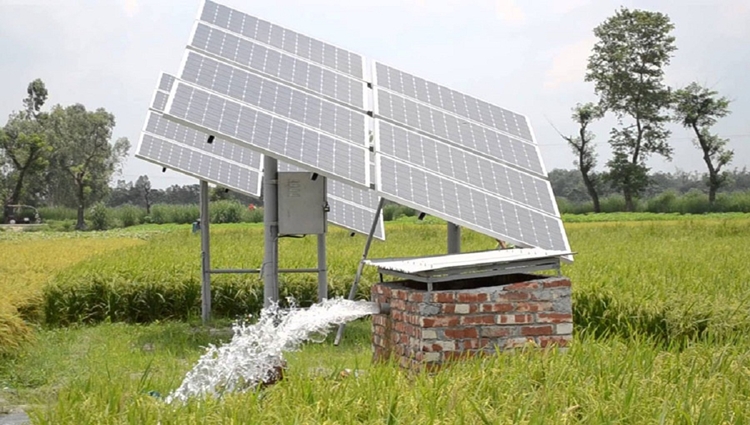Abu Taher Bappa
Published:2019-12-02 23:15:38 BdST
Solar irrigation holds promise for low-cost farming
FT ONLINE
After getting good success in solar home systems in off-grid areas, the government is now planning to use solar power extensively for irrigation, given its cost-effectiveness.
The environment-friendly solar-powered pumps can provide farmers a sustainable solution to the irrigation crisis they face every dry season. Irrigation accounts for a major part of the cost for cultivation.
Farmers can use solar pumps to irrigate their crops at a cheap cost for a long time and without polluting the environment.
At present, the country has 1.34 million diesel-run pumps which consume 2.9 million tonnes of diesel worth $1 billion annually. Most irrigation in the country is done by such pumps. And the government needs to spend a large amount of money on subsidising the fuel to make it affordable for farmers.
The country also has 240,000 electricity-run pumps which put extra 1,500-megawatt pressure on the power grid daily during the dry season when irrigation is required.
Against this backdrop, the solar irrigation system is opening up a new door for low-cost crop cultivation, particularly for the Boro paddy, without requiring any fuel.
Officials of the power division said they are now focusing on installing solar pumps not only to reduce farming costs but also to reduce carbon emissions.
Various organisations and agencies are also trying to promote the use of solar-powered irrigation pumps across the country to reduce carbon emission.
At present, the country has 1,446 solar irrigation pumps which have a combined generation capacity of 31 megawatts per hour.
Of the total number solar pumps, the Infrastructure Development Company Ltd (IDCOL), a state-owned non-bank financial institution, has financed the installation of 1,270 solar irrigation pumps which have a cumulative capacity of producing about 28.78 megawatts per hour.
IDCOL has set a target to install 50,000 solar irrigation pumps by 2025, and the government has made low-interest loans available to the company for this purpose.
A programme has also been taken up by the Department of Agricultural Extension, Bangladesh Agricultural Development Corporation and other ministries and departments to install solar-powered pumps.
The government wants to replace diesel-run pumps with solar-powered pumps which will have a power generation capacity of 150 megawatts, a senior official at Bangladesh's Sustainable and Renewable Energy Development Authority (SREDA) told The Business Standard.
BREB to install 2000 solar pumps by 2020
Apart from SREDA and IDCOL, the Bangladesh Rural Electrification Board (BREB) has also taken up a project to set up 2000 solar irrigation pumps through its 10 Palli Bidyut Samity offices by December 2020.
The Asian Development Bank (ADB) is financing this project under its Power System Efficiency Improvement Project.
The project aims at expanding the use of Solar Photovoltaic (PV) pumping systems for irrigation and reducing a sudden thrust on grid power during the irrigation season. It also focuses on minimising carbon emissions by avoiding the use of diesel-based pumps.
Md Sakil Ibne Sayeef, director of the solar irrigation pump project, said that they have completed the preparatory work.
"We have called a tender to give the contract for engineering, procurement and construction. Now we are evaluating the tender documents. Hopefully, we will be able to start the work at the beginning of the new year," he said.
Farmers can sell excess power
The Bangladesh Agriculture Development Corporation says that a solar-powered irrigation panel is used for a maximum of 120 days in a year. Each panel is idle for the rest of the year.
During the January-April irrigation season in Bangladesh, solar irrigation pumps will use the power they generate for their primary purpose, but for the rest of the year – especially during the hot season from May to October – net-metering will enable solar pump owners to generate revenue by selling excess power back to the national grid.
Net metering is a billing mechanism that credits solar energy system owners for the electricity they add to the grid.
The government has a plan to connect solar irrigation panels to the national grid to take unconsumed electricity after the end of an irrigation season.
The Sustainable and Renewable Energy Development Authority is now working to finalise a guideline and a roadmap to this end.
Under a pilot project, SREDA has run a solar irrigation panel at Kalinathpur in Kushtia with the capacity of generating 24.4 kilowatts of electricity per hour.
Md Manzur Morshed, director (Energy Audit) of SREDA, said, "A net-metering policy will soon be finalised. Under the policy, we will set the process of how excess electricity can be taken from solar irrigation pumps."
Unauthorized use or reproduction of The Finance Today content for commercial purposes is strictly prohibited.


